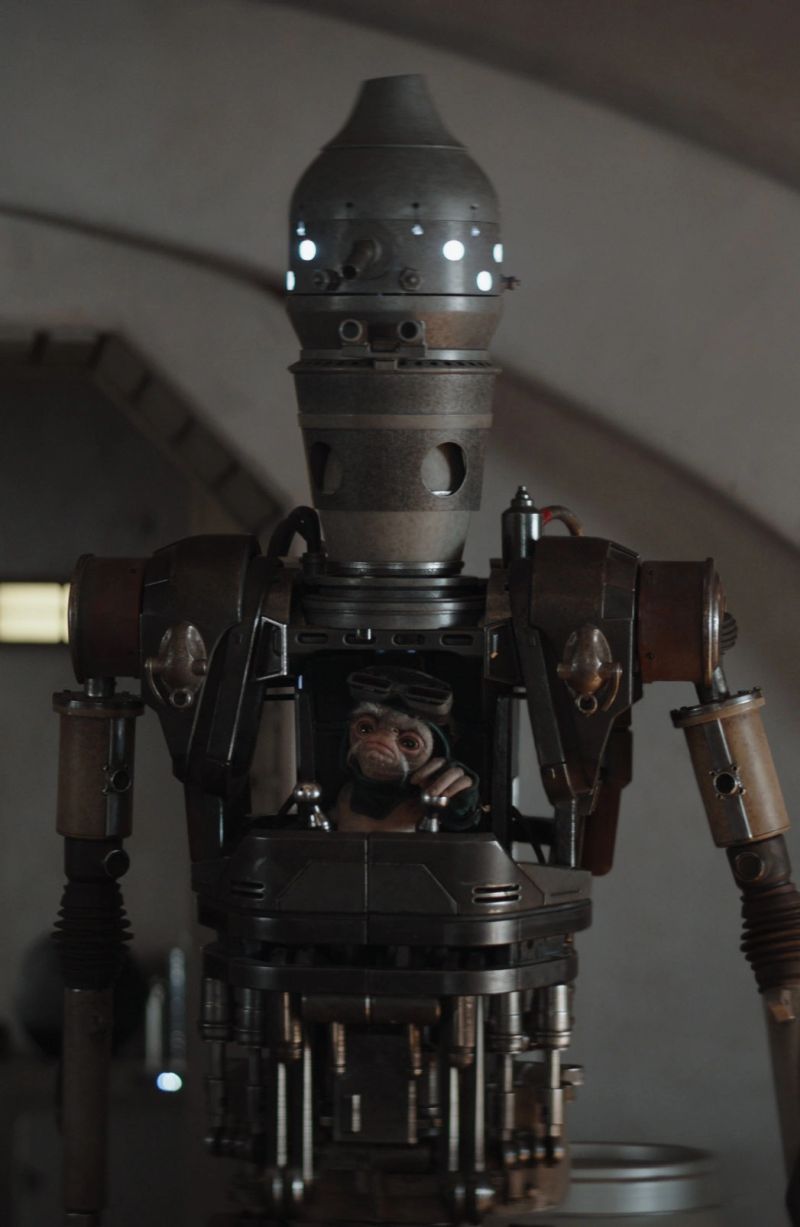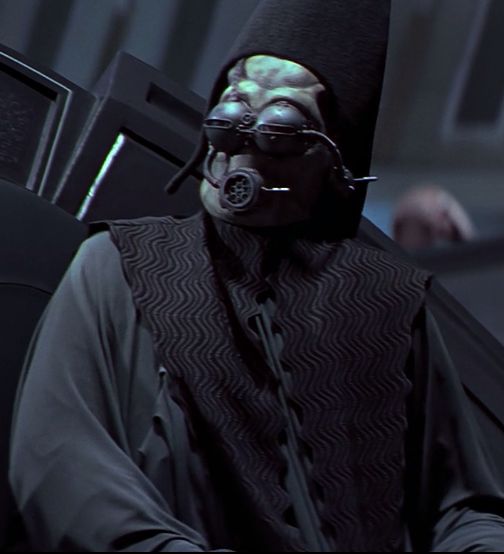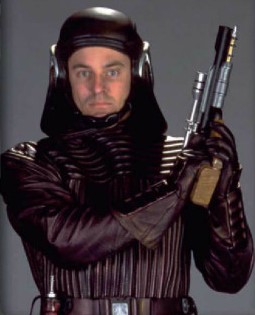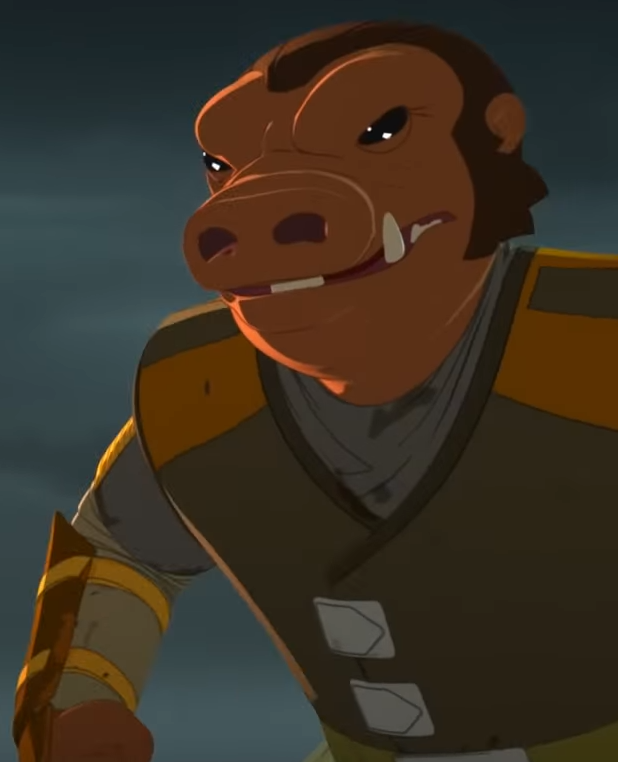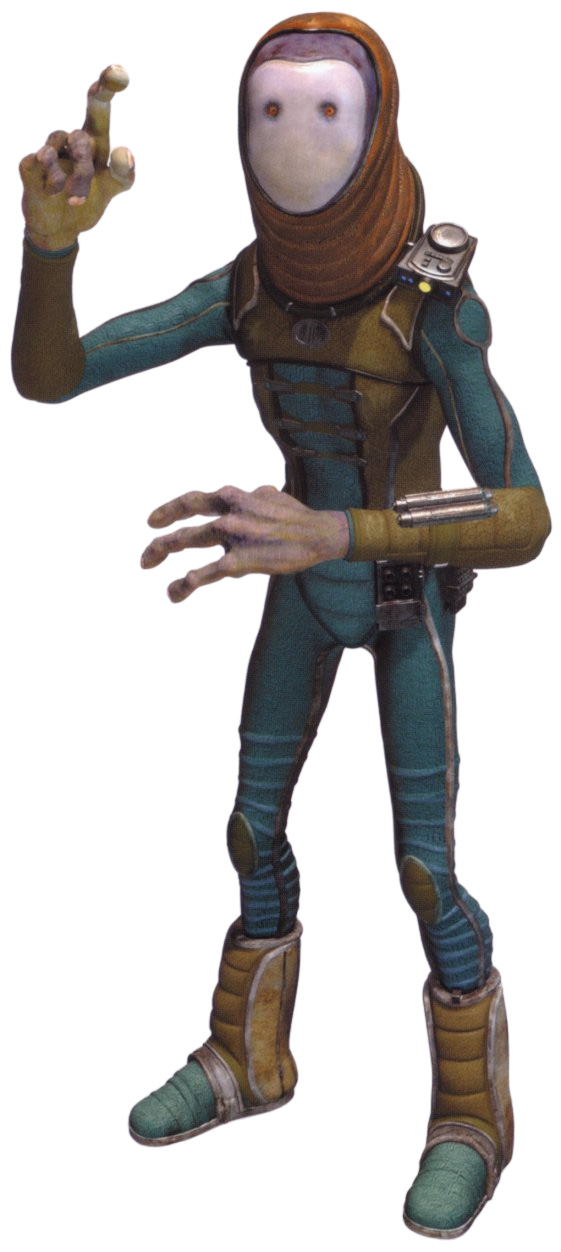 Name: Kallidahin (Polis Massan)
Subspecies: Speaker
Average height: 1.4 meters
Skin color: Gray
Eye color: Black
Distinctions: Commonly mute, four fingers, lack of facial features
Homeworld: Kallidah
Language: Massan
Attribute Dice: 12D
Dex: 2D/4D
Know: 2D/4D
Mech: 2D/4D
Perc: 2D/4D
Str: 2D/3D+1
Tech: 2D/4D+2
Special Abilities:
Telepathy: Kallidahin communicate through a form of telepathy allowing them to send thoughts and simple feelings to any willing subject within 15 meters. This does not allow them to receive thoughts only send them, and allows them to communicate with others without being sensed by others.
Thick Skinned: Kallidahin have thick smooth fibrous skin which insulates them from the environment as their cetacean ancestors were, giving them +1D to resist heat, cold, and pressure differences.
Osmotic Membrane: Kallidahin faces are blank osmotic membranes which allow them to filter harmful substances from being breathed or absorbed by their bodies, giving them a +1D to resist such substances.
Story Factors:
Mute: The majority of Kallidahin have no vocal cords and therefore cannot speak, relying upon their telepathy or shoulder mounted translators they often use to communicate with members of other species.
Featureless: Kallidahin faces are blank featureless osmotic membranes making it almost impossible to read their emotions except through body language, giving them a +1D to all skills which hiding their emotions may help, such as Con, resisting Interrogation, etc.
Move: 8/10
Description: The Kallidahin, also known as Polis Massans, were a race of sentient cetaceans native to the world of Kallidah, having obtained their misleading name due to their extensive century-spanning digs on their adopted home in Polis Massa. The Kallidahin lacked facial features and were commonly mute, resorting to signs and telepathy to communicate. Though they had little contact with other species and were considered hermetic, they were known for their extraordinary medical, archaeological and xenobiological skills, and were regarded as compassionate beings who understood the value of life. They were also known for their massive xenobiology database.
Members of this species were mainly concerned with their excavation in Polis Massa, where they were secretly trying to find proof of any relationship between their own species and the original inhabitants of Polis Massa, the extinct Eellayin. Although they did little to contact the wider galaxy beyond their business with the similarly secretive Kaminoans, they were kind to any visitors. The Kallidahin helped Jedi Masters Yoda and Obi-Wan Kenobi several times, including trying to save the life of their ally Padmé Amidala and taking care of the last stages of her pregnancy. In later years, the Alliance to Restore the Republic built an outpost in Polis Massa that was eventually raided by the Galactic Empire, but the locals were unmolested during this time.
Biology and appearance
The average Kallidahin was a short, thin being unable to walk as fast as a Human would or, on average, to compare to a Human's strength. They had skinny bodies covered by soft gray skin that, being thick, smooth, and partially insulating, pointed to their aquatic, cetacean ancestors. Their fibrous figures were also surrounded by anatomical features known as growth rings. During the Old Republic era, xenobiologists could not identify the evolutionary reason that the species developed this tree-like trait.
The head was connected with the body through a long, thin neck. A member of the species had a flat, pale face, covered by an osmotic membrane that left them featureless. The only facial feature was a pair of black eyes. Those visual organs lacked any expressiveness, but they were deep-focus and useful for work deep underground and for research in the field of medicine. A member of this species also had thin arms with nimble gray hands, each with four long, dexterous fingers including an opposable thumb.
Most Kallidahin were mute due to a natural lack of vocal cords. Their language, known as Massan, combined computers, sign language, and the use of their mildly telepathic brains. Their telepathy was not related to the thought transmission used by adepts of the Force, although it worked similarly when broadcasting thoughts and simple feelings to willing receivers in a fifteen-meter area. The Massan language has been described as falling beyond the Human auditive spectrum when used in its purest form. However, a small subset of Kallidahin, referred to as "speakers" by their people, did possess vocal cords and could physically speak languages such as Galactic Basic Standard, though their voices were soft and strangely resonant.
Society and culture
The Kallidahin were known for their compassion and kindness, while their also characteristic discretion was not as widely known. They greatly valued freedom and life in any form and had such a peaceful nature and respect for life that only rarely would they follow a soldier's career. Although able to protect themselves and their culture when the need arose, they were not an aggressive species and rejected direct confrontations even when the greater goals of the species were at risk.
They felt an overwhelming desire to gain data about other species, as they were analytical and felt the research was particularly important when related to the origins of their own species. They were gifted xenobiologists but, being unskilled in diplomacy, preferred study from afar instead of direct interaction with the beings of interest.
The species also had galaxy-wide fame for their skill in the fields of archaeology and medicine. Their medics, while not as abundant as their excavators, were known for being dedicated healers. Many members of the species were miners or speleologists, and wore form-fitting bodysuits fitted with all manner of signaling devices, medical equipment and utility pouches. The majority of these miners were seasoned spelunkers, and dug deep into the core of the asteroid field of Polis Massa to locate prize artifacts. All of them were committed and enthusiastic workers who commonly enjoyed a full day of work in the core of the asteroid field.
History
Origins
Although most of the galaxy believed the Kallidahin to be the original inhabitants of the planetoid Polis Massa, the species had actually evolved on a different world known as Kallidah, in the Subterrel sector.
The planet Polis Massa, in the more isolated limits of the Outer Rim Territories, was instead the original home of a subterranean civilization known as the Eellayin Many centuries before the Battle of Yavin, Polis Massa exploded due to a natural disaster whose cause would remain unknown in further years. The native Eellayin mysteriously vanished afterwards and the Kallidahin and the Republic subsequently considered the Eeyallin to be extinct. The planet became an asteroid field, with the biggest asteroid being renamed Polis Massa.
Given Kallidahin reticence, few details were known of their past before the sixth century BBY. At some point in the past, this species made a deal with another one to learn the cloning techniques from the secretive clone-masters known as Kaminoans. The Kaminoans agreed to the deal in exchange for certain xenobiological data in the Kallidahin archives. Although the Kallidahin were not as adept as Kaminoans, they managed to employ the cloning technology sufficiently to re-build biological matter they had found in archaeological digs. They believed themselves to be descendants of the ancient Eellayin species once native to Polis Massa, although they kept this conviction in secret. The Kallidahin also learned to use cloning for medical purposes, although they were not as advanced as the Kaminoans in this field.
Later, in the sixth century BBY, the Archaeological Research Council decided to establish a Research Base on the largest of the asteroid remnants of the Polis Massa system, by then known as Polis Massa, to unearth evidence of this evolutionary link.
Circa 519 BBY, the entire population of Kallidah left their homeworld to mine at Polis Massa. They traveled to the biggest asteroids in the system to start looking for clues. The main objective of the species in successive years would be discovering their real connection with the Eellayin. Although their civilization officially covered the whole asteroid field, only the biggest asteroids had a settled population. They organized their new life in Polis Massa, centered around an archaeological dig that would be surrounded by a mining colony. As the asteroids lacked a natural atmosphere and the Kallidahin were oxygen-breathers, they resorted to airtight buildings. They built their new capital, Polis Massa Base, and organized imports of food, water and machinery, even if the system had no real exports. They also built, in one of the closed habitats, a high-quality medical center mostly equipped for the physiological needs of Kallidahin patients.
In later centuries, they found many artifacts and remains of the Eellayin, although real proofs of the relation, commonly coming from the depths of the Polis Massa asteroid, were scarce. The species had trouble with treasure hunters wanting to plunder their digs, and with the raising piracy in the Outer Rim Territories. The inhabitants of Polis Massa were quiet in their work to avoid attracting any undesired attention and refused to get involved with the rest of the galaxy, but nevertheless they kept their politeness when dealing with aliens.
When their initial research began to take dozens of decades, the Kallidahin chose to remain in Polis Massa and continue their task for as long as needed; soon, they had been away from Kallidah for so long that the species had no living memories of their own origin. At that point, aliens in the galaxy began calling the Kallidahin with the name of Polis Massans because they had been living in Polis Massa for centuries. The species humbly accepted their new name, feeling honored and with no objection.
At some point during their research, the Kallidahin found the remains of Wiyentaah, an Eellayin city, and built an installation over it, to carefully excavate the metropolis little by little. Because many of the unearthed artifacts were fragile, they were kept in secure, sterile rooms.
Other cultures began to speculate about the real connection between the Kallidahin and the Eellayin, but the Kallidahin were silent in that respect. As the Kallidahin were always anxious to learn about xenobiology, many other species believed that their traditional drive was their real motivation. They said they wanted to preserve the memory of the lost Eellayin, but certain outsiders believed they really wanted to resurrect their ancestors using their cloning technology. The species now called Polis Massans had previously cloned extinct lifeforms in other places. Following this hypothesis, they had not succeeded in cloning Eellayin because they had not found adequate genetic material.
The Kallidahin also began building droids through a company known as Polis Massa Pria Assemblage. They mostly manufactured machines for their own use instead of exporting them, mainly archaeological droids and miner droids; but they also needed help in skills beyond xenobiology, like obstetrics. Apparently to that end, they built the Chroon-Tan B-Machine, which had a face inspired in the species'.
Another alien who had had contact with the Kallidahin was Yoda, a renowned Jedi Master. Yoda had dealt with the Kallidahin Maneeli Tuun, operational head of the medical center of Polis Massa and firm supporter of the Galactic Republic.
Order 66
In 19 BBY, Yoda became a fugitive and, along with his ally Bail Organa, went to Polis Massa looking for a haven. He had chosen this asteroid field partly because it was remote, adequate to harbor him, and partly because he knew he could count on Tuun. Yoda was soon joined by his allies Jedi Master Obi-Wan Kenobi, droids C-3PO and R2-D2 and pregnant, injured Senator Padmé Amidala, all of them traveling in Amidala's star skiff. They asked the Kallidahin to help during the childbirth.
However, the available obstetricians were mostly members of an archaeological dig team, with only two of them being seasoned physicians; the others were exobiologists. Amidala's condition was so severe that they had no time to look for more prepared doctors. The doctors even had to operate in their mining bodysuits, not having a minute to change clothes. The Kallidahin who treated her were Maneeli Tuun, Dznori Xam and Selif Xam, with the added presence of Osh Scal, a non-medic supply officer.
Recognizing their unfamiliarity with Human parturition, the Kallidahin consulted their databank and resorted to a Chiewab Amalgamated GH-7 medical diagnosis droid, an advanced droid of which they had several units, to deal with Amidala's injuries; and a seldom-used Chroon-Tan B-Machine to help with the childbearing.
Although Amidala had twins, Luke and Leia, she had lost any will to live and slowly refused to recover. The Kallidahins and the droid did everything in their power to save her life, but failed. R2-D2 secretly recorded all the events with his holocam.
To keep the births a secret, the Jedi decided to simulate that Amidala was still pregnant when she had died. The discreet Kallidahin agreed to keep the secret, even if they probably did not understand the galaxy-wide importance of it. Kenobi and Yoda asked them to erase any record of the births, including a memory wipe of the used medical droids. However, the doctors had performed safety tests to the newborns, consuming several supplies, and the supply record was forgotten during the deletion. The Jedi and Organa left soon afterwards, heading to Naboo to bury Amidala.
The Imperial Inquisition
Soon afterwards, the by-then Emperor Palpatine set up the Inquisitorius, formed by special Intelligence agents, including an Inquisitor Malorum in charge of the planet Bellassa. A source informed Malorum about the burial of Amidala, telling him that a Jedi had taken the corpse from Polis Massa to Naboo. Malorum wanted to discover more details about this to use the information against his rival Darth Vader √Ę‚ā¨‚ÄĚ secretly the father of Amidala's children.
Malorum hired Boba Fett, a teenaged bounty hunter, to examine the medical records of the Polis Massa clinic and also Naboo. Never giving his own name, Fett visited Polis Massa as an Imperial investigator, copied all the files and took them to Malorum. Thanks to the precautions taken after the birth, those documents were useless to Malorum.
Meanwhile, Obi-Wan Kenobi joined forces with former Padawan learner Ferus Olin against Malorum, particularly when Kenobi discovered Malorum's interest in Polis Massa.
Malorum dispatched a new agent, an Inquisitor by the name of Sancor, who was an expert in record security. The personal interest of the Inquisitorius might have led the Kallidahin to suspect that the birth was more important than they had previously thought. Sancor dealt with Tuun and searched the memory banks of the medical droids. Sancor later asked Tuun for the supply records and the presence of supply officer Osh Scal. As Scal was among the few members of this species who had an audible voice, Sancor could question him personally.
Obi-Wan Kenobi, following his instincts, split up from Olin to visit Polis Massa. Kenobi intercepted Tuun before the Inquisitor could find Scal and the Jedi asked Scal to forge the records Sancor was analyzing, giving him a more important, although fictional, fugitive to track. Kenobi also disguised himself as a Kallidahin and met with Sancor, pretending to be Scal; during the questioning, Kenobi tried to misdirect the Inquisitor.
However, Sancor saw a graphic depiction of the real Scal in the records and noticed that Kenobi did not look like him. Sancor attacked Kenobi and Tuun, but Kenobi scared him by activating his lightsaber. Sancor tried to escape from the system to report to Malorum. Kenobi and him struggled, and Sancor was killed. In order to cover Kenobi's tracks, Tuun then sent a message to Malorum, describing the "accidental" death of his envoy who fell from an observation platform and landed on sharp chirurgical tools.
Kenobi had to leave the asteroid soon afterwards. He met with Olin and asked him to take care of Malorum. Kenobi specifically asked Olin to not allow Malorum to discover whatever had happened in Polis Massa.
Malorum met with Darth Vader soon afterwards and mentioned that he was researching events in the planetoid Polis Massa. Darth Vader forcefully requested Malorum to forget any work in that direction. Olin, who was secretly eavesdropping on the conversation, was sure that Malorum would continue probing Polis Massa.
Malorum personally visited Polis Massa soon after this event; however, even he was unable to find anything there. He then tried his luck on Naboo and discovered useful information. Malorum was then found by Olin and died while dueling him; the truth about the birth in Polis Massa remained a secret.
Galactic Civil War
During the first days of the Alliance to Restore the Republic, a movement that started in 2 BBY, the Rebel command mounted a secret base on Polis Massa. The Alliance launched several operations from this base, although the crew did their best not to disturb the nearby excavations.
The Empire raided this base repeatedly without achieving its destruction; during all these conflicts, the digs of the Kallidahin were untouched. In 0 BBY, when Darth Vader sent his elite 501st Legion to recover important information that the Rebels had stolen, the Empire annihilated the base and killed all the Rebels, again without disturbing the nearby Kallidahin.
Later conflicts
During the Yuuzhan Vong War (25√Ę‚ā¨‚Äú29 ABY), the Yuuzhan Vong invaders found no reason to raid Polis Massa: it was too remote and held no strategic value or important resources that they could use. The later Dark Nest Crisis of 36 ABY was similarly clement with the Kallidahin. During this campaign, however, R2-D2 showed his holorecording of Polis Massa to by-then adult Luke Skywalker, his wife Mara Jade Skywalker and his nephew Jacen Solo, along with other files of Padm√ɬ© Amidala's later days. By then, Jade was suspected to have murdered her husband's mother, and the droid's files served to clear her name.
Kallidahin in the galaxy
Perceived by others as silent and weird, Kallidahin were considered among the most mysterious species in the galaxy. The mute, faceless sentients were not social creatures in the way Humans could be. They limited their contact with other species as a way to protect their work. The Kallidahin had a massive database with xenobiological information about many alien species, but nevertheless they had little face-to-face contact with other cultures. Probably the most exhaustive contact the Kallidahin had with another species was with the Eellayin, an extinct people whose memory they tried to preserve in their digs.
The Kallidahin, commonly restricted to the Polis Massa system, rarely encountered any other sentients beyond the pirates and treasure hunters who wanted to profit from the locals' hard work. The Kallidahin had dealt with the similarly reclusive Kaminoans in the past, obtaining important technology in exchange for their data on xenobiology, but the Polis Massans would rather be secretive about the results of their work.
Sometimes, the Kallidahin went beyond the borders of the Polis Massa system, commonly for exobiological reasons, but in those cases they did not go too far. Soon before the Clone Wars, some exobiologists of this species were sent to a different planet in the Subterrel sector to perform research. The local fauna included fierce predators, but the exobiologists managed to keep them at bay using Kamino saberdarts they had obtain in their deals with the Kaminoans. Another traveler to the planet, a Besalisk known as Dexter Jettster, witnessed the use of the saberdarts and was impressed with them.
Although their personality and telepathic abilities could have given them excellent careers in the Jedi Order, or in certain criminal activities, there were no known precedents of Kallidahin Jedi or rogues.
Some Kallidahin, including Maneeli Tuun, supported the Galactic Republic following their firm beliefs, but they remained mostly beyond the reach of the Republic's judicial arm. Jedi Master Yoda, and later Jedi Master Obi-Wan Kenobi, were known to have trusted this cetacean of firm ideals.
|









